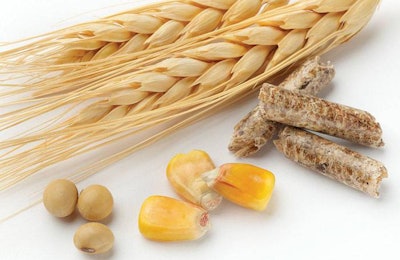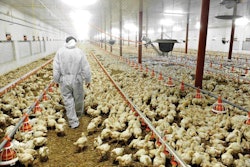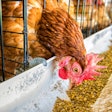
High prices for common cereals have come and gone since ancient times. The only assurance we have is that these cycles will continue, and what better times to consider measures against them now that prices appear to be normal. After all, when everybody will be looking to deal with the next wave of high cereal prices, it will be too late to find and test sources of alternative ingredients or measures to reduce the impact of using expensive ones.
Feed cost is traditionally assumed to be about 60 percent of total expenditure needed to raise a market bird or pig. When prices for common cereals above historical average levels, this figure can reach 80 percent. In a market where net margins are often below 5 percent, such dramatic increases in cost can drive a healthy enterprise into bankruptcy.
The easiest way to handle expensive feed is to improve the feed-to-gain ratio, or feed efficiency. Anything that reduces the amount of feed required per unit of weight gain also reduces feed cost per unit of gain. But, this is not the only measure. The following are some general ideas regarding non-nutritional and nutritional strategies to control, if not lower, feed cost.
1. Exercise purchasing power
It is a business axiom that if you want lower prices you have to buy more or buy for a longer period of time. It makes sense to assume that increasing purchasing power (either increasing the volume per transaction or the duration of a purchasing contract) lowers prices per unit of weight. Back in 2004, when cereal prices became unreasonably high for the first time in recent history, several producers had already made 10-year contracts with cereal producers to lock in prices ahead of the forthcoming crisis. The DDGS era has been blamed by many for bringing about expensive cereals, and if this is true, the problem will persist for the foreseeable future.
2. Adjust market weight
It is also well known that when feed is expensive, pigs should get to the market sooner. This also applies to poultry raised for the heavier broiler and turkey markets, but the room for adjustment is clearly less in these species. In general, growing animals tend to deposit more and more fat after their protein deposition potential peaks. This adversely affects the feed/gain ratio, meaning that weight gained late in market life is not as efficiently gained as weight earlier on. This is just a matter of fact due to the greater energy required to deposit one gram of fat compared to one gram of lean tissue! To find the optimal market weight the use of a modern growth model can be of tremendous value.
3. Talk to your genetics supplier
Through the same mechanism of depositing less fat, as described above, leaner genetics can offer substantial feed cost savings. Leaner animals cost less to produce, and this solution might be easy for pigs (by switching terminal sire semen supplier) but rather difficult in broilers and turkeys where commercial genetic lines do not offer such wide variability as in pigs. Nevertheless, poultry genetic companies offer several distinct lines that could be more profitable to raise during periods of expensive feed cost. In general, early-maturing animals, those that deposit most of their protein potential early on in life, are most profitable to raise when feed is expensive, but on the other hand, these animals must be marketed at lighter weights.
4. Buy new feeders or fix the ones you have
If approximately 25 percent of feed is wasted through poor management of feeders, feed and animals, it is a golden opportunity now to resolve this chronic issue by training personnel, fixing feeders and reallocating feeders. Each percentage unit wastage reduced is a percentage unit savings in feed/gain ratio. Most farms don’t even realize the extent of wastage until it is actually measured. Wastage about 10 percent is considered normal in most farms, but with careful management, this figure can be reduced to below 5 percent. Switching feeders to address the issue of feed wastage is easier on broiler farms, especially if only the feeding pan needs replacing, but this can be a serious investment for pig farms.
5. Engage your veterinarian
It is no secret that healthy animals grow leaner and more efficiently compared with those of suboptimal health. Malnutrition early in life is also “compensated” by depositing more fat and organ tissue later when nutrition becomes normal again in pigs. In contrast, in broilers, offering a super pre-starter appears to give them a boost that lasts throughout their market life. So, it pays to keep animals healthy and thriving. Making the feed denser, hence even more expensive, never fails to increase the cost of production without offering the expected growth rate improvement. Sick or challenged animals do not eat because the problem they face prevents them from growing. Stuffing them with extra nutrients does not resolve their main problem (disease or challenge) and only leads to wasted nutrients. So, improving overall farm hygiene is the only solution to faster and more efficient growth.
6. Cull out additives based on return on investment
Using the right additives for each farm should be the work of a qualified nutritionist. Additives should be evaluated based on return on investment. Usually, additives that improve growth below 4-5 percent are difficult to justify during hard times. Cast a critical eye on additives and question whether they really are worth the expense and trouble. Use only the ones that really work on each farm. Not all additives work on all farms or at all times. During difficult times, additives are the first to be purged from formulations, leading to variable results. Hence, the need for a knowledgeable nutritionist to cull out only those that can be safely removed.
7. Explore your feed mill’s potential
It has been determined by pioneering work done at Kansas State University by Dr. Joe Hancock’s laboratory that for every 100 microns reduction in particle size, feed efficiency improves by 1.4 percent. This applies to pigs, whereas in broilers the results are mixed; some studies suggest a benefit, others a detriment, when particle size deviates from the established medium. At any rate, the expected improvement in feed efficiency should not be outweighed by the cost of grinding cereals to a finer particle size. Grinding soybean meal has not resulted in improved performance, and as such any efforts should be focused on cereals alone.
8. Test your cereals for enzyme compatability
Here, we will consider enzymes against the major non-starch polysaccharides found in cereals, especially in wheat (arabinoxylans) and barley (beta glucans). Data for corn-based diets are unclear, at best. But, for diets based on wheat and barley, particularly if these cereals are of poor quality (as defined by a large concentration of non-starch polysaccharides), the addition of a cereal-specific enzyme should increase metabolizable energy concentration by about 50 kcal/kg complete feed. Effects on protein digestibility are not well documented, so it’s recommended to base your calculations on energy savings alone. Again, the cost of using such an enzyme should not be outweighed by the cost of providing a similar amount of energy through other sources (lard, tallow, soy oil, etc). It is widely accepted that broilers benefit more often than pigs from added enzymes, but in my opinion, it is the quality of cereals that dictates results more than the species of animals.
9. Buy the right anti-mycotoxin agent
Pigs and poultry suffer in different forms and degrees by similar mycotoxins and levels of contamination. It is always best to determine the predominant mycotoxins for the cereals used and then apply a specific product, instead of using a blanket approach that usually costs more and does not cover region-specific mycotoxin problems. For example, corn from one region might be more often contaminated with aflatoxins, whereas corn from another region might suffer from a host of totally different mycotoxins. Only when the sources of cereals are variable and unpredictable is it advised to use a cocktail of anti-mycotoxin agents with a wide spectrum of coverage.
10. Find a nutritionist to balance diets and profits
Balancing a feed for a specific animal weight and purpose is easier said than done, as it requires the use of a growth model to compare nutrient requirements versus nutrient supply. And, this is the first step. Then, a qualified nutritionist is required to assess the changes needed to match the two together in an effort of cutting cost by reducing excesses, covering deficiencies or, preferably, both. Again, a qualified nutritionist with full access to farm-specific conditions is required to find the perfect balance that will maximize profitability.
11. Reconsider pelleting
Pelleted feed is most likely to improve feed/gain ratio by 5 to 15 percent depending on diet nutrient composition, ingredients used and, of course, the species and weight class of the animals. For example, greater improvements are expected in younger animals, such as broilers and piglets. As always, the extra cost of pelleting should not be greater than expected benefits, especially when the price of fuels is extremely high. Pelleting also offers additional benefits that could be factored in when assessing its financial impact on nutrition cost.
Pelleting offers additional benefits that could be factored in when assessing its financial impact on nutrition cost.
12. Seek out alternative cereals now
Usually this is the first solution that comes to mind when cereal prices go up. But, unless you lock in a large quantity of such alternatives before the market adjusts, it is highly unlikely such ingredients will remain competitive for long. It is a fact in world trade, when the prices of reference ingredients increase, then prices of alternatives also increase just below the point where the use of such alternatives is no longer financially rewarding. Keep in mind, alternative cereals all come with a steep learning curve.
















